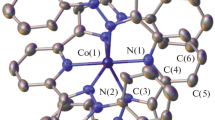Abstract
Two complexes based on isophthalic acid ligand were successfully synthesized and structurally characterized. Compound 1 exhibits a three-dimensional supramolecular structure. It is assembled from L3− ligands to form a 2D layer with the water ligands orientated above and below each layer. Adjacent layers are connected through hydrogen bonding between carboxylic groups and coordinated, free water molecules to generate a three-dimensional supramolecular structure. The structure of compound 2 consists of tetranuclear cobalt clusters which were linked by the acid ligands to generate a layered structure. Neighboring layers are further connected through bpp ligands to form a three-dimensional structure. The variable-temperature magnetic susceptibility data show that complexes 1 and 2 exhibit antiferromagnetic interactions.





Similar content being viewed by others
References
Fu JH, Wang SY, Chen YS, Prusty S, Chan YT (2019) One-pot self-assembly of stellated metallosupramolecules from multivalent and complementary terpyridine-based ligands. J Am Chem Soc. https://doi.org/10.1021/jacs.9b08731
Huang RW, Wei YS, Dong XY, Wu XH, Du CX, Zang SQ, Mak TCW (2017) Hypersensitive dual-function luminescence switching of a silver–chalcogenolate cluster-based metal–organic framework. Nat Chem 9:689–697
Cao LH, Wei YS, Xu H, Zang SQ, Mak TCW (2015) Unveiling the mechanism of water-triggered diplex transformation and correlating the changes in structures and separation properties. Adv Funct Mater 25:6448–6457
Li HY, Wei YL, Dong XY, Zang SQ, Mak TCW (2015) Novel Tb-MOF embedded with viologen species for multi-photofunctionality: photochromism, photomodulated fluorescence and luminescent pH sensing. Chem Mater 27:1327–1331
Yu S, Hu ZB, Chen ZL, Li B, Zhang YQ, Liang YN, Liu DC, Yao D, Liang FP (2019) Two dy(III) single-molecule magnets with their performance tuned by schiff base ligands. Inorg Chem 58(2):1191–1200
Li B, Fan HT, Zang SQ, Li HY, Wang LY (2018) Metal-containing crystalline luminescent thermochromic materials. Coord Chem Rev 377:307–329
Wu YP, Tian W, Liu S, Li B, Zhao J, Ma LF, Li DS, Lan YQ, Bu XH (2019) Bi-microporous metal–organic-frameworks with cubane [M4(OH)4] (M = Ni, Co) clusters and pore space partition for electrocatalytic methanol oxidation reaction. Angew Chem Int Ed 58:12185–12189
Yang XG, Ma LF, Yan DP (2019) Facile synthesis of 1D organic–inorganic perovskite micro-belts with high water stability for sensing and photonic applications. Chem Sci 10:4567–4572
Feng X, Feng YQ, Guo N, Sun YL, Zhang T, Ma LF, Wang LY (2017) Series d − f heteronuclear metal–organic frameworks: color tunability and luminescent probe with switchable properties. Inorg Chem 56:1713–1721
Yaghi OM, O’Keeffe M, Ockwig NW, Chae HK, Eddaoudi M, Kim J (2003) Reticular synthesis and the design of new materials. Nature 423:705–714
Wang YF, Li SH, Ma LF, Geng JL, Wang LY (2015) Syntheses, crystal structures, and magnetic studies of two cobalt(II) coordination polymers based on concurrent ligand extension. Inorg Chem Commun 62:42–46
Wang YF, Li Z, Sun YC, Zhao JS, Wang LY (2013) Structural modulation and properties of four cadmium(II) coordination architectures based on 3-(pyridin-4-yl)-5-(pyrazin-2-yl)-1H-1,2,4-triazole and aromatic polycarboxylate ligands. CrystEngComm 15:9980–9987
Jiang K, Ma LF, Sun XY, Wang LY (2011) Syntheses, structures and luminescent properties of zinc(II) coordination polymers based on bis(imidazole) and dicarboxylate. CrystEngComm 13:330–338
Li B, Zang SQ, Wang LY, Mak TCW (2016) Halogen bonding: a powerful, emerging tool for constructing high-dimensional metal-containing supramolecular networks. Coord Chem Rev 308(1):1–21
Wei YS, Hu XP, Han Z, Dong XY, Zang SQ, Mak TCW (2017) Unique proton dynamics in an efficient MOF-based proton conductor. J Am Chem Soc 139:3505–3512
Pahari G, Bhattacharya B, Reddy CM, Ghoshal D (2019) A reversible photochemical solid-state transformation in an interpenetrated 3D metal–organic framework with mechanical softness. Chem Commun. https://doi.org/10.1039/C9CC04765D
Lin LD, Li Z, Zhao D, Liu JH, Li XX, Zheng ST (2019) Development of a new Lindqvist-like Fe6 cluster secondary building unit for MOFs. Chem Commun 55:10729–10732
Shyshkanov S, Nguyen TN, Chidambaram A, Stylianou KC, Dyson PJ (2019) Frustrated Lewis pair-mediated fixation of CO2 within a metal–organic framework. Chem Commun 55:10964–10967
Xia QC, Yuan C, Li YX, Cui Y (2019) Design and assembly of a chiral composite metal–organic framework for efficient asymmertric sequential transformation of alkenes to amino alcohols. Chem Commun 55:9136–9139
Sheldrick GM (1996) SADABS: program for empirical absorption correction of area detector data. University of Göttingen, Germany
Sheldrick GM (2008) A short history of SHELX. Acta Crystallogr A 64:112–122
Zhao F, Dong ZP, Liu ZL, Wang YQ (2019) A new cobalt coordination framework based on trinuclear Co(II)-tetrazolate bridges and a terpyridine tetrazolate ligand: synthesis and magnetism. Inorg Chem Commun 107:107465
Wang LW, Shang QG, Zhou JJ, Zhou H, Pan ZQ, Cheng QR (2018) Crystal structures and properties of two linear trinuclear complexes. Chin J Inorg Chem 34(5):957–966
Zhou L, Fan HH, Zhou BL, Cui Z, Qin BW, Zhang XY, Li WL, Zhang JP (2016) Tetranuclear cobalt(II)-isonicotinic acid frameworks: selective CO2 capture, magnetic properties, and derived “Co3O4” exhibiting high performance in lithium ion batteries. Dalton Trans 48:296–303
Park JH, Lee WR, Ryu DW, Lim KS, Jeong EA, Koh EK, Hong CS (2012) Sulf-incorporated Co(II) coordination framework with bis-imidazole bridging ligands constructed by covalent and noncovalent interactions. Cryst Growth Des 12:2691–2698
Acknowledgements
The work was supported by the National Natural Science Foundation of China (NSFC) (21671114 and 21401112), the Young Backbone Teachers Fund of Henan (2018GGJS119) and Scientific research and service platform fund of Henan Province (No. 2016151); The fund of scientific and technological innovation team of water ecological security for Water Source Region of Mid-line of South-to-North Diversion Project of Henan Province; and Nanyang Normal University.
Author information
Authors and Affiliations
Corresponding authors
Ethics declarations
Conflict of interest
The authors declare that they have no conflict of interest.
Additional information
Publisher's Note
Springer Nature remains neutral with regard to jurisdictional claims in published maps and institutional affiliations.
Electronic supplementary material
Below is the link to the electronic supplementary material.
Rights and permissions
About this article
Cite this article
Li, R., Liu, S., Du, B. et al. Synthesis, structures and magnetic properties of cobalt(II) complexes derived from 5-(4-(1-(carboxymethyl)-1H-pyrazol-3-yl)phenyl)isophthalic acid ligand. Transit Met Chem 45, 203–210 (2020). https://doi.org/10.1007/s11243-019-00371-x
Received:
Accepted:
Published:
Issue Date:
DOI: https://doi.org/10.1007/s11243-019-00371-x




